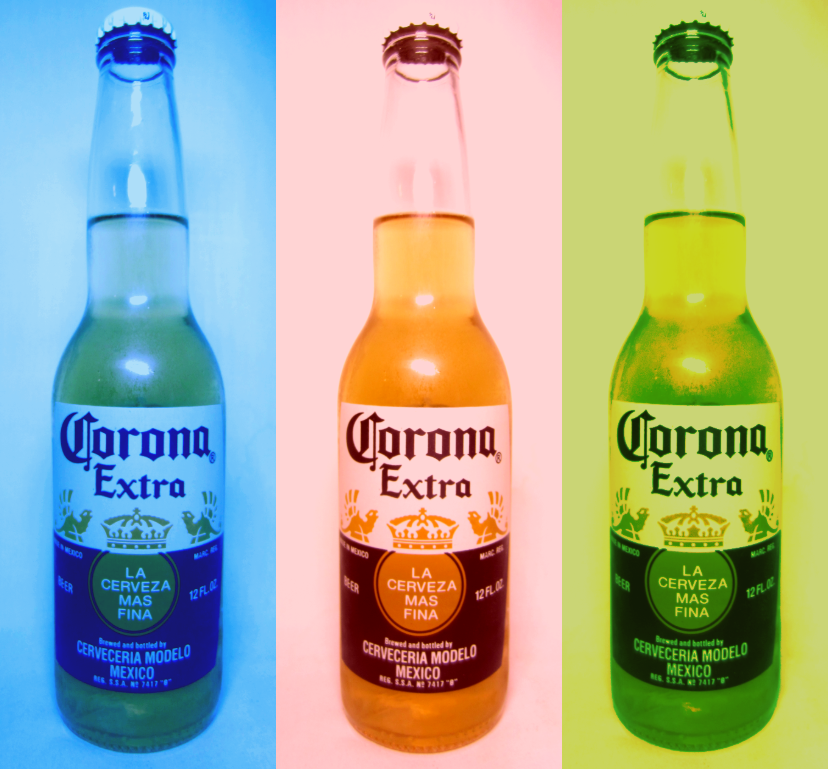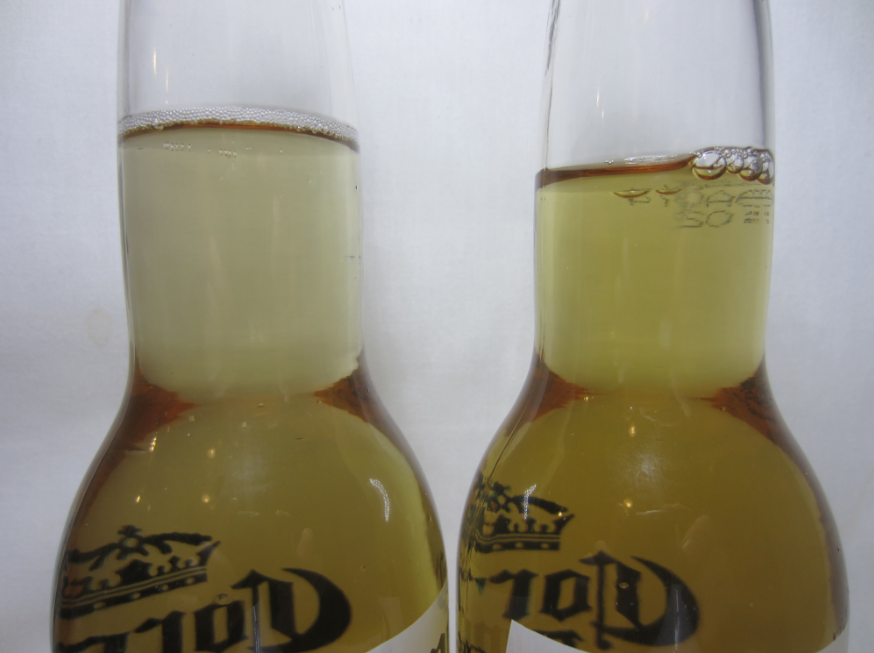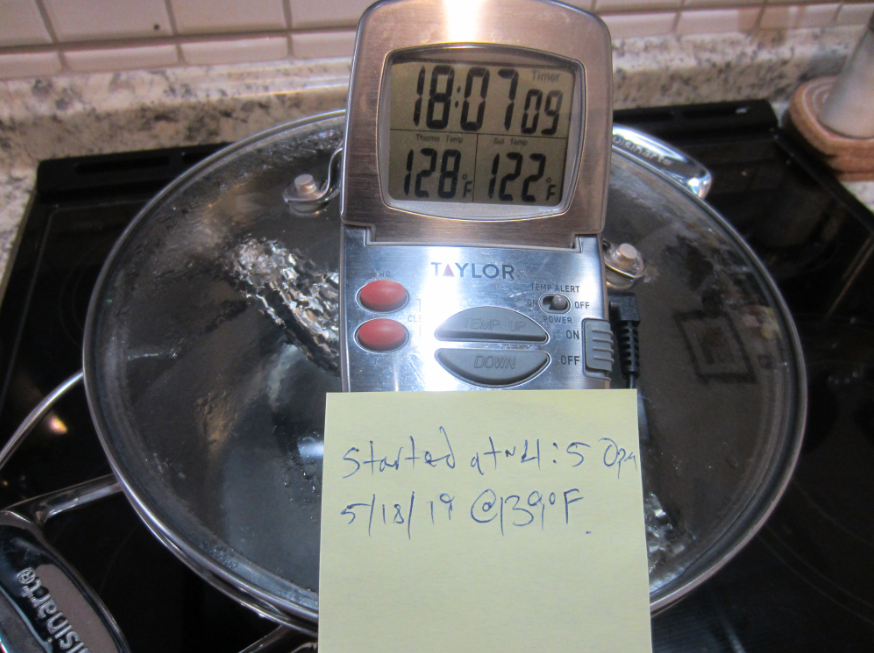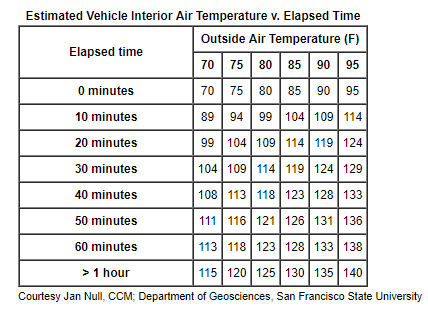In the following experiments, we subjected a light beer (Corona Extra) to a barrage of separate extreme tests to measure the individual impacts of freezing, heat and light exposure.
TASTE TEST PROCESS
We conducted repeated taste tests to see if any noticeable change could be detected using a kind of blind sensory method called a “triangle test”. For example, when testing the effects of a certain factor like “beer exposed to light”, three unmarked samples of beer were poured, one of which was a sample that had been exposed to light, and the other two were unadulterated samples.
The testers were then asked to identify the sample they believed was different, and then the same test was repeated between 4 and 6 times to reduce the possibility that the testers were simply guessing correctly. The tasters were not told in what way any beer had been altered. Tasters were instructed to consider and describe the aroma, flavor, and carbonation level of each sample.
All beer samples were measured at three ounces each and served into snifter glasses at 50°F (10°C) in order to enhance the tester’s ability to detect any differences.
CHOICE OF BEER
The beer used in all experiments was Corona Extra, which was chosen in part due to its world-wide distribution making it more accessible to anyone who wanted to repeat any of these experiments on their own. The other reasons a light beer like Corona was selected was because it’s said that it is easier to detect flaws in such light beers, and being bottled in a clear bottle makes the beer more susceptible to the effects of light exposure. All beers purchased came from the same closed box (protected from light exposure), and were purchased from and subsequently kept in cold storage. None of the control beers were determined to have any off-flavors.
THE EXPERIMENTS OF ICE, FIRE AND LIGHT:
THE IMPACT OF FREEZING BEER
It’s said that freezing and thawing a beer will reduce the level of carbonation in beer generating a “flatter” tasting beer. Curious to see if a tasting panel could repeatedly identify a beer that had been frozen and then thawed compared to an unadulterated beer from the same case, a beer was frozen for two hours, thawed, and served immediately to a tasting panel who were asked to repeatedly identify the beer that was different.
The panelists were not told that the beer was frozen, but only to identify the beer that was different and describe what was different about it.
OBSERVATIONS
The tasting panel was able to correctly identify the frozen and then thawed beer with an accuracy rate of 75%. The frozen and then thawed beer was described as slightly less carbonated and slightly less aromatic, and having a subtly duller flavor. One taster noted a more “watery” character in the aroma.
The frozen and then thawed beer was also slightly lighter and hazy than the unadulterated beer as can be seen below (frozen and thawed beer on left, unadulterated beer on right):
To account for the minor difference in color, tasters were blindfolded, but were nevertheless still able to correctly identify the frozen and then thawed beer 75% of the time based on the aroma, flavor and carbonation level.
REFLECTIONS
The results of this test seem to reflect the commonly held ideas about the effects of freezing beer. Interestingly, some tasters were able to correctly differentiate the beers by scent alone, while others could only correctly tell the difference by the different level of carbonation. We approximate that the level of carbonation in the frozen beer was reduced by about 20-25%, resulting in fewer aromatics being generated for the nose to detect, and though no difference in flavor was noticed, folks did notice a difference in carbonation level resulting in what some described as a slightly duller beer.
Overall, the impact of freezing beer in this case was subtle and at times difficult to detect.
THE IMPACT OF HEATING BEER
It’s said that when beer is exposed to heat, it can reduce the shelf life of the beer by accelerating chemical reactions including oxidation. (It should be noted that aging certain styles of beer can be desirable as with certain Belgian sour beers and beers with higher alcohol concentrations.)
Curious to see if any noticeable change could be detected in heated beer, we wrapped a bottle of Corona Extra in aluminum foil to protect against light exposure, submerged the bottle in warmed water at a temperature range of 90-139°F (32.22-59.44°C) for 24 hours, chilled to 50°F (10°C) and served immediately.
The general idea with this experiment was to approximate the effect of beer left in a hot car. Although temperatures in a hot car can reach upwards of 172 F (77.78°C), we capped the testing temperature at 139°F (59.44°C).
For reference, below is a chart estimating vehicle interior air temperature v. elapsed time:
OBSERVATIONS
Tasters were able to correctly identify the heated beer 90% of the time by scent alone, with some tasters accuracy rate at 100% over 6 repeated trials. Tasters described the aroma of the cooked beer as somewhat sulfury with notes of hard boiled eggs, sulfury mud, raw grey clay, and cooked corn. The heated beer was also described as having slightly lower carbonation, and was less crisp and less hoppy in both aroma and flavor as compared to the unadulterated beer. No difference in color was noted, but less of an alcoholic kick was noted in the heated beer.
REFLECTIONS
The degree to which heat negatively affected specifically the aroma of the beer tested was striking. Where one might have expected characteristics associated with oxidation in a heated beer such as cardboard, sherry, or apple juice, instead sulfur notes were detected.
However, the sulfury notes that were identified, especially in the aroma of the heated beer, might be explained by the fact that the hydrogen sulfide level in filtered beer consistently doubles after pasteurization, which illustrates that the level is not static, but is affected by various redox reactions that take place in the packaged beer.
We essentially pasteurized the beer multiple times when repeatedly reheating the beer to 122–140°F (50–60°C) over 24 hours, thereby increasing the potential level of hydrogen sulfide which has a low sensory threshold of only a few parts-per-billion.
THE IMPACT OF EXPOSING BEER TO LIGHT
When beer is exposed to UV light, particularly in the range of 350-500 nm, a reaction occurs in hops that can cause the beer to take on a “skunky” or “marijuana-like” character. The particular offending chemical compound generated in this light-caused reaction is called 3-methyl-2-butene-1-thiol, or “3-MBT” for short, and can occur in under 10 seconds resulting in what is referred to as a “skunked” or “light-struck” beer. A potent compound, humans are able to detect 3-MBT at a threshold of around 4 parts-per-trillion.
The color of glass beer is bottled in can affect this skunking reaction, with brown bottles offering better protection, green bottles far less, and clear bottles none. This is why folks might notice this phenomenon more often with beers like Heineken and Beck’s that are bottled in green bottles, and beers like Corona packaged in clear bottles. Many brewing companies well-aware of this phenomenon continue to package their beer in clear or green glass bottles mainly due to marketing and branding priorities.
Some brewing companies such as Miller Brewing avoid the lightstruck problem in brands such as Miller High Life by using specially formulated hop extracts that do not react with UV light to create 3-MBT.
To test the impact of UV light on beer, clear bottles of Corona Extra were left in direct contact with sunlight for 10 hours at a temperature range of 60-69°F (15.56 -20.56°C), chilled to 50°F (10°C) and served immediately along with two unadulterated samples. We figured even though it’s said that a beer can be skunked in as little as 10 seconds, just to be safe we might as well leave it exposed for 10 hours.
OBSERVATIONS
After repeating the same test four times to minimize any doubt of lucky guessing, panelists were able to correctly identify the beer that had been exposed to UV light each time with a 100% accuracy rate and by scent alone. Although a strong skunk musk aroma was immediately noticeable upon opening the bottle, once the beer was served, bonus aromatics were noted including rotten vegetables (rotten squash), water from a backed-up kitchen sink, burnt rubber/plastic, and dirty waste water from a wet vac after cleaning a carpet.
REFLECTIONS
While certainly a skunk-like aroma was expected from exposing a light beer to UV light, the additional aromas of drain water, burnt rubber, and rotten vegetables were not. That said, the chemical produced by beer exposed to UV light that causes the skunk-like aroma is called 3-MBT, a kind of mercaptan, which has also been described as burnt rubber. However there are actually a variety of mercaptans that may be found in beer, such as methanethiol (methyl mercaptan) which has been described as “like drains or rotting garbage”, descriptors similar to aromas noted about this ultra lightstruck beer.
In short, it seems this unfortunate beer was first struck by light, and then by a garbage truck.
That said, the worst of the offending aromas seemed to become somewhat muted after leaving the opened lightstruck bottles of beer out indoors at room temperature for about 24 hours, suggesting that some of the mercaptans are volatile or perhaps intermediary byproducts in a longer chain of chemical reactions.
By the way, if you’re interested in a more formal scientific analysis of the effects of lightstruck beer over the course of several days, here’s a link to a 1965 Japanese paper called “Studies of the Sunlight Flavor of Beer”.
Sunlight never tasted so gross.
Hi, I’m Dan: Beer Editor for Beer Syndicate, Beer and Drinking Blogger, Certified Beer Judge, Award-Winning Homebrewer and Cider Maker, Beer Reviewer, American Homebrewers Association Member, Shameless Beer Promoter, and Beer Traveler.









marc
10 hours in the light? 5 minutes would suffice.
Daniel J. Leonard
Agreed, at least if the goal was to generate the effects of a lightstruck/skunked beer. But it turned out that by leaving the beer exposed to light for that long of a duration (10 hours), more than just the typical 3-MBT skunk must aroma was detected. For example, folks perceived methanethiol-like aromas, or some compound exhibiting “rotten vegetables” and “backed-up kitchen sink water”, which were much more offensive than a skunked beer.